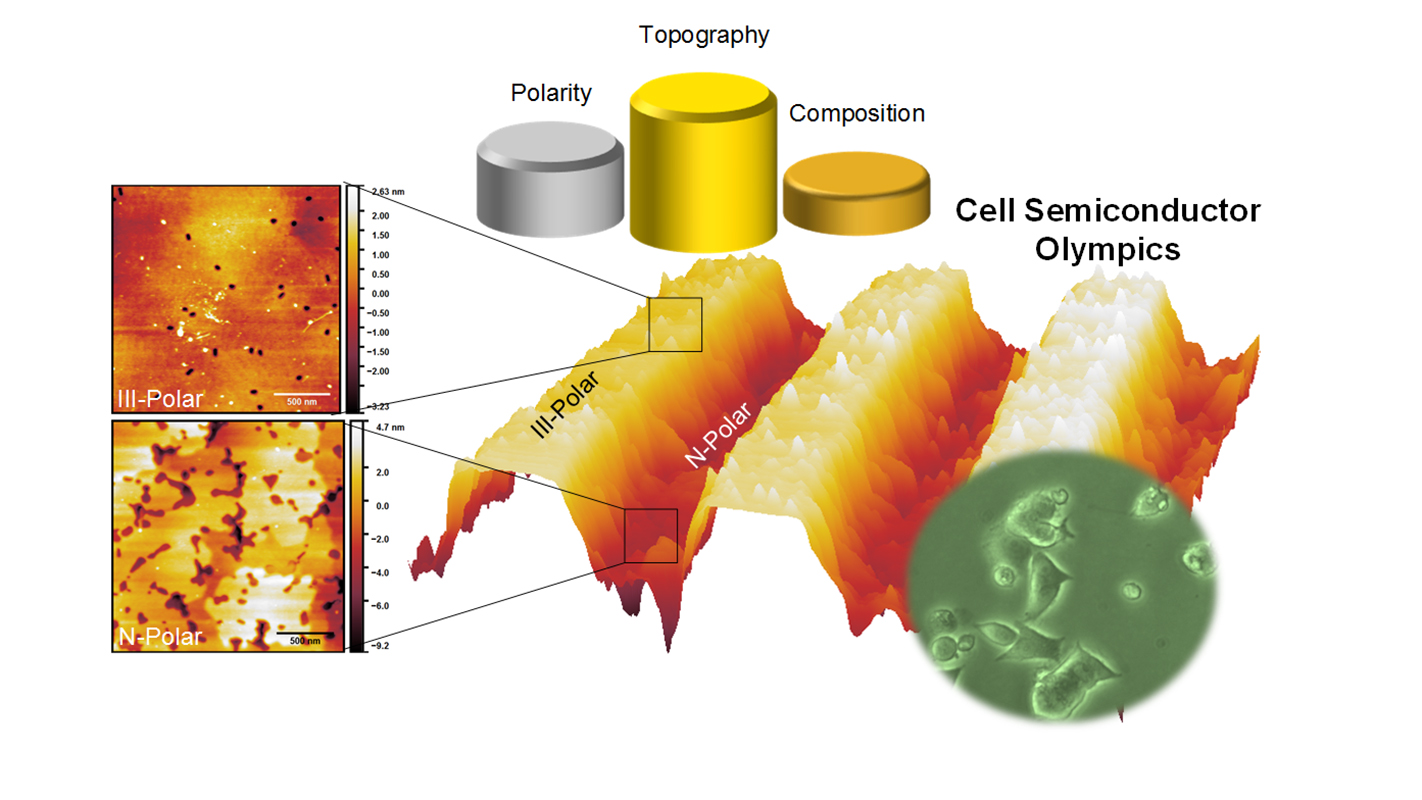For Immediate Release
Researchers at North Carolina State University have determined that the surface texture of gallium nitride (GaN) materials can influence the health of nearby cells. The work is significant because GaN is a material of interest for developing new devices that can control cellular behavior.
GaN materials have a unique suite of properties that make them viable candidates for bioelectronic devices: you can tune the charge on the surface of the materials; the materials don’t easily degrade in aqueous environments like the body; and they are nontoxic.
“But while living cells will survive in the presence of GaN, we wanted to know if we could influence the behavior of the cells by changing the make-up of the GaN material,” says Patrick Snyder, a Ph.D. student at NC State and lead author of a paper on the work. “Basically, we wanted to know if engineering the GaN could influence the health and metabolism of the surrounding cells.”
To do this, the researchers tested three different materials: GaN, and two variations of aluminum gallium nitride – Al0.8Ga0.2N and Al0.7Ga0.3N. The researchers manipulated the surface of the materials, creating rough and smooth versions of each. Lastly, the researchers modified the surface chemistry of the materials to make them more or less attractive to water – hydrophilic or hydrophobic, respectively.
For example, there were six types of GaN material: hydrophobic, hydrophilic and unmodified rough GaN; and hydrophobic, hydrophilic and unmodified smooth GaN. The same was also true for both compositions of AlGaN.
The researchers then used the various GaN materials as substrates for growing PC12 cells – a line of well-studied model cells that are well understood.
During the seven-day experiment, the researchers monitored the cell cultures to track the health and metabolism of the cells.
“We found that the roughly-textured AlGaN compositions released more gallium into the cellular environment,” Snyder says. “While this did not kill the cells, it did cause metabolic changes.”
“This tells us that the topography of the material matters, and can influence cellular behavior,” says Albena Ivanisevic, a professor of materials science and engineering at NC State and co-author of the paper. “The work demonstrates that surface textures of bulk materials – like those used to create devices – can have similar effects to what we’ve previously seen in nanoscale materials.”
The paper, “Nanoscale topography, semiconductor polarity and surface functionalization: additive and cooperative effects on PC12 cell behavior,” is published online in the journal RSC Advances. The paper was co-authored by Ramon Collazo, an assistant professor of materials science and engineering at NC State; and Ronny Kirste, a postdoctoral researcher at NC State who is also affiliated with Adroit Materials. The work supported by the U.S. Army Research Office under grant W911NF-15-1-0375; and by the National Science Foundation under grant DMR-1312582.
-shipman-
Note to Editors: The study abstract follows.
“Nanoscale topography, semiconductor polarity and surface functionalization: additive and cooperative effects on PC12 cell behavior”
Authors: Patrick J. Snyder, Ramon Collazo and Albena Ivanisevic, North Carolina State University; Ronny Kirste, North Carolina State University and Adroit Materials
Published: Oct. 10, RSC Advances
DOI: 10.1039/C6RA21936E
Abstract: This work compares the behavior of PC12 cells on planar and patterned III-nitride materials with nanostructured topographies. Three different materials’ compositions containing N-polar and Ga-polar areas are studied: Al0.8Ga0.2N, Al0.7Ga0.3N, and GaN. Surface microscopy and spectroscopy, along with biological assays are used to understand the connection between nanoscopic features, polarity and surface functionalization. All materials are modified using a solution based approach to change their surface composition. The results demonstrate that altering the surface hydrophobicity can be used to generate additive effects with respect to protein adsorption in addition to the cooperative effects observed with respect to planes’ polarity and topography. The work also details differences in the release of metal ions from clean and functionalized nanostructured III-polar and N-polar semiconductors in cell culture media, and their relationship to changes in cell response through quantification of cell viability and the production of reactive oxygen species. Our results demonstrate that nanoscale topography can be linked to additional parameters at the cell-semiconductor interface in order to understand and modulate PC12 cell behavior.
- Categories:



